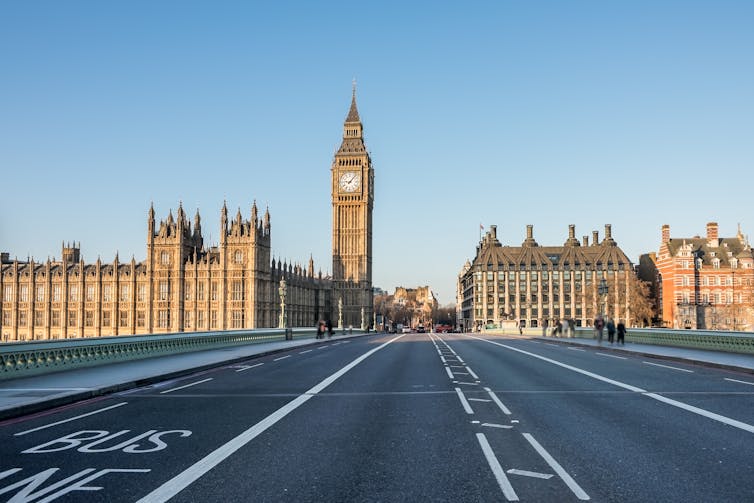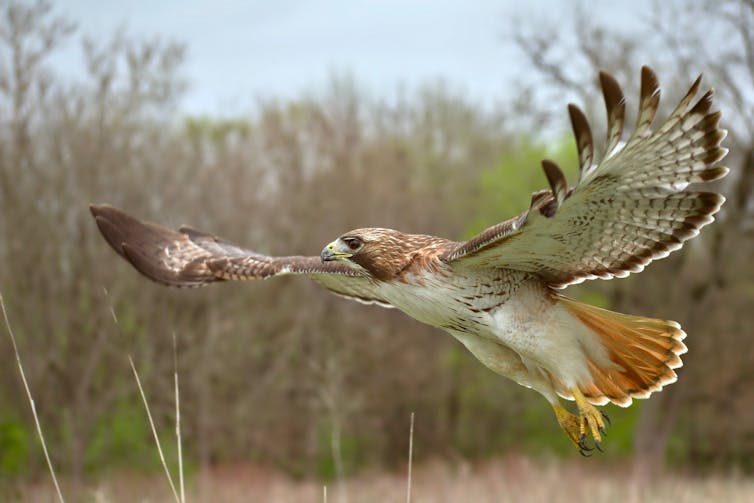How COVID lockdowns triggered changes in peregrine falcon diets – and what this means for urban pest control
Lockdown wasn’t good news for London’s peregrine falcons.
March 10, 2023 • 7 min • Source
Many people saw their eating habits change during the COVID-19 lockdowns. Some ate more frequently or experimented with healthier recipes. Others ordered more deliveries.
But human diets weren’t the only ones to change. In a recent study , we found that lockdown triggered changes in the diets of London’s peregrine falcons. London is home to as many as 30 breeding pairs of peregrines (one of the world’s largest urban populations).
The emergence of high-definition web cameras now means that scientists can record every bit of food that peregrines feed to their young. Our team of 50 citizen scientists analysed live stream footage from peregrine nests across 27 English cities to determine what the birds were eating. We observed the nests throughout the 2020-2022 breeding seasons, allowing us to track the changes to their diets that occurred during and outside of lockdown periods.
In London, peregrines ate a lower proportion of feral pigeons (-15%) during the lockdowns. Instead, they caught more starlings (+7%) and ring-necked parakeets (+3%).
Peregrine falcons depend on prey animals like pigeons for food. But, as pigeon populations themselves are contingent on humans, peregrines are vulnerable to changes in human activities. Our results demonstrate that humans are a key, but underappreciated, part of the ecology of urban environments.
Bird watching, for science
Pigeons – which descended from the cliff-dwelling rock dove – have adopted our cities as their homes. In highly urbanised cities, humans support feral pigeons both intentionally and otherwise through the production of litter and food waste. These pigeons are now present in such vast numbers across London that feeding them is banned in particular locations, including Trafalgar Square.
Around 13 million racing pigeons are also released into the wild in the UK each year – and some of them will turn up in our cities. Birds of prey subsequently catch 8% of these pigeons . Yet, the importance of racing pigeons to the diet of urban peregrines remains uncertain.
When pandemic restrictions were imposed, the pigeon racing season was suspended and these birds were confined to their lofts. Feeding opportunities for feral pigeons also dwindled in urban areas as people were advised to stay at home. This forced hungry pigeons to spread out in search of alternative food sources, meaning fewer pigeons were present for peregrines to feed on.
The wide geographic coverage of our study also revealed that the effects of social restrictions on peregrine diets were uneven across the UK. London was the only city studied where the proportion of pigeons eaten dropped significantly. Across the other cities studied, pigeons took 0.3% more pigeons on average during lockdown periods than outside of them – an insignificant change.
This is likely due to London’s particularly large non-residential central area. The city’s core emptied as people stopped commuting and the food and retail sector ground to a halt . So London’s pigeons had to cover more ground than their counterparts in smaller cities to reach residential areas where people could still feed them.

Rethinking pest control
Large pigeon flocks that are drawn to humans in parks or squabble over food waste at litter bins are familiar sights for city dwellers. We take these daily interactions for granted or see them as pests. But pigeons contribute to the success of apex predators like the peregrine falcon.
Pigeons are subject to pest control programmes globally. Countries like Singapore and Switzerland have opted to manage pigeon populations by targeting their human food sources. For example, the Swiss city of Basel halved its street pigeon population between 1988 and 1991 by prohibiting their feeding.
These measures are often imposed to improve public hygiene. Research has found that pigeons can pass infectious diseases like ornithosis and paramyxovirus onto humans through their droppings.
Their excrement is also corrosive and can cause substantial damage to buildings. In 2003, the then Mayor of London Ken Livingston said pigeon droppings had caused up to £140,000 worth of damage to Nelson’s Column and other monuments in Trafalgar square.
But pigeon management overlooks the needs of the wildlife that share our cities. Our study offers a glimpse into how these efforts may have consequences for apex predators particularly in large cities, where the raptors may be more vulnerable to swings in the population of their pigeon prey.
Previous research found that measures to control rat populations in the eastern US city of Philadelphia in 2013 forced red-tailed hawks to switch to eating pigeons, which they are poorly suited to catching. While London’s peregrines had starlings and parakeets as backup prey during lockdown, raptors in cities worldwide face the growing pressure of their prey being eradicated to protect humans from disease.

Given the importance of pest species to urban falcons, we must consider what could happen to urban raptor populations if these “undesirable” pest species are eradicated. The ecological impacts of the COVID-19 lockdowns remind us that we are part of urban ecosystems. Perhaps it’s time to reconsider how we co-exist with urban animals, working with rather than against them.
Brandon Mak received research funding from the British Trust for Ornithology and King's College London for this study.
Ed Drewitt received a small grant from the British Trust for Ornithology to support the purchase of some equipment that supported this study.
